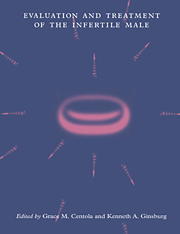Book contents
- Frontmatter
- Contents
- Preface
- List of contributors
- 1 Andrology
- 2 Sperm–egg interaction
- 3 Routine semen analysis
- 4 Computer-aided sperm analysis: a critical review
- 5 Antisperm antibodies: diagnosis and treatment
- 6 The sperm penetration assay
- 7 Intrauterine insemination for male factor
- 8 Processing human semen for insemination: comparison of methods
- 9 New assays for evaluating sperm function
- 10 Assisted reproductive technology for male factor infertility
- 11 Microinjection techniques for male infertility
- 12 Therapeutic donor insemination: screening, indications and technique
- 13 Endocrine assessment and hormone treatment of the infertile male
- 14 The urologic evaluation of the infertile male
- 15 Azoospermia: the diagnosis and treatment
- 16 White blood cells in semen and their impact on fertility
- 17 Psychological aspects of male infertility: lifting the shroud of shame
- 18 Evaluation of the female partner
- Index
7 - Intrauterine insemination for male factor
Published online by Cambridge University Press: 16 September 2009
- Frontmatter
- Contents
- Preface
- List of contributors
- 1 Andrology
- 2 Sperm–egg interaction
- 3 Routine semen analysis
- 4 Computer-aided sperm analysis: a critical review
- 5 Antisperm antibodies: diagnosis and treatment
- 6 The sperm penetration assay
- 7 Intrauterine insemination for male factor
- 8 Processing human semen for insemination: comparison of methods
- 9 New assays for evaluating sperm function
- 10 Assisted reproductive technology for male factor infertility
- 11 Microinjection techniques for male infertility
- 12 Therapeutic donor insemination: screening, indications and technique
- 13 Endocrine assessment and hormone treatment of the infertile male
- 14 The urologic evaluation of the infertile male
- 15 Azoospermia: the diagnosis and treatment
- 16 White blood cells in semen and their impact on fertility
- 17 Psychological aspects of male infertility: lifting the shroud of shame
- 18 Evaluation of the female partner
- Index
Summary
Introduction
Earlier this century, Dr Robert L. Dickinson of New York City, during a symposium on infertility, described intrauterine insemination as follows: After the patient is positioned, ‘the tenaculum steadies the cervix and serves to draw open the canal, which should rarely need to be wiped and on which no antiseptic should be used. The pipette is now very gently filled. The tip touches first the interior of the cervical canal as high as may be and is passed to near the fundus. Gentle, steady pressure is made on the bulb until “unwell feelings” are produced and are continued till there is consciousness of slight distress in the sides of the abdomen low down, at which time the fallopian tubes are presumed to have fluid in them.’ (Dickinson, 1921). In his article, Dr Dickinson beautifully described all aspects of this procedure as a possible treatment of male factor infertility. Dr Edward Reynolds of Boston, in discussing Dr Dickinson's paper, commented that ‘Washing semen through the tubes impresses me as unphysiologic. I should want to see a large number of successes before I was ready to use it. The use of artificial insemination promiscuously without careful isolation of the cases which are due largely to cervical obstacles, I believe to be thoroughly unscientific and not free from danger. It comes down, in short, to the general principle that routine adoption of any procedure for a condition which is a result of multiple and varying causes is poor practice’ (Reynolds, 1921). Interestingly, this discussion took place at the Forty-fifth Annual Meeting of the American Gynecological Society in Chicago, Illinois, on 26 May 1920.
- Type
- Chapter
- Information
- Evaluation and Treatment of the Infertile Male , pp. 72 - 88Publisher: Cambridge University PressPrint publication year: 1996
- 2
- Cited by

